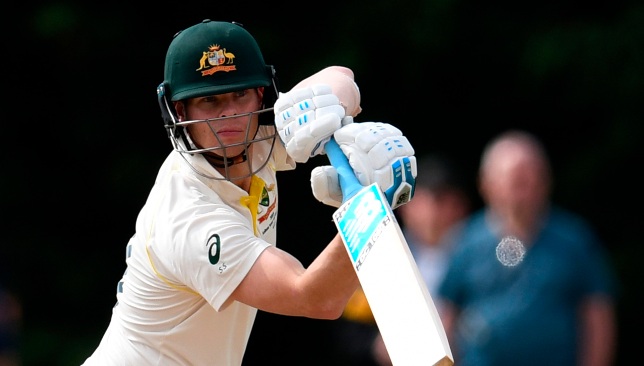
The cover drive is widely regarded as the most elegant stroke in cricket but on one occasion during the Ashes at Old Trafford, the best Test batsman of his generation may have played the ugliest version of it.
Steve Smith showed little consideration for the coaching manual when he fished wide outside off-stump to connect with a loose Ben Stokes delivery in the first innings of the fourth Test.
Rule number one of executing a cover drive is to transfer your weight forward and get your front foot as close to the pitch of the ball as possible. Smith however plays this shot on his back foot – though still leaning into the strike – with his front pointing towards mid-on, about as far away from the ball as physically possible.
Balance is also crucial but in an attempt to reach the delivery with his unorthodox stance, the Aussie is falling over. In fact, at the point of impact his left leg is airborne and his follow through sees him end up on the deck.
Batting coaches everywhere wince. But they don’t look away … because it’s absolutely fascinating.
And ultimately, none of those technical transgressions matter when the reality is the ball raced away to the fence, bringing up his half-century.
Of course, he would continue in his stunning vein of form as he has throughout the Ashes and notch up his third double hundred and second against England.
Smith almost single-handedly set up an Australia for the win, one that ensured they drew the series and retained the Ashes despite losing the fifth and final Test – during which he would score another half century.
He ended the series with a mammoth tally of 774 runs from seven innings and did so with the same untidy technique that’s worked marvelously for him but would likely be catastrophic for anyone else. What it essentially does is simplify his shot selection and forges an arc within which he’s able to score runs with minimum risk.
Shuffling across the crease, his stance leaves his head placed just outside off-stump, facing that dangerous corridor of uncertainty almost head-on. He knows exactly where his wickets are and leaves any decent delivery that doesn’t threaten them.
A ball at his stumps will be met with a straight bat, unless it’s angled in enough – then the face closes and it’s worked to the leg-side for runs. Bowl further down leg and his eyes light up before a fielder is forced to retrieve the ball from the boundary.
Of course, he won’t operate exclusively on the leg-side. Part of his approach is about playing every ball on its merit. He’s always in a position to dispatch bad deliveries to all parts of the ground.
And that brings us back to his shot against Stokes – a cover drive/back-foot punch hybrid if you will.
On initial viewing, his technique and form is deplorable but closer inspection reveals much to admire.
2015: Double century at Lord’s
— ESPNcricinfo (@ESPNcricinfo) September 5, 2019
2017: Double century at Perth
2019: Double century at Old Trafford!
Steve Smith. Simply Bradmanesque! 👏👏👏 #ENGvAUS #Ashes pic.twitter.com/WTrpKHLsQp
Ignore the bottom half of his body. Focus on his torso and up – apart from that offensive bat position as he winds up like a baseball player, of course. There’s still plenty there that can still find a place in the coaching manuals his overall style seems to rip up.
First, his head is very still even as he begins to crouch before falling forward. Then, you notice how he picks up the length early and watches the ball the whole way – completely in control of the situation despite the improvisation involved.
Most impressive though is the drive. There’s no typical high elbow to speak of because he’s extending but the bat is remarkably straight and follows through with a flourish. He doesn’t slash, he plays it with the full face of the bat and the rest of his body contorts any way it needs to for him to make the sublime contact he’s striving for.
Look at the shot frame-by-frame. After the strike and at the peak of his follow through, there’s something incredibly symmetrical about his form. Down on one knee, weight in the direction of the shot and front foot extended to the leg-side in a straight line for maximum impact. It’s almost … beautiful.
Then there’s the aspect of his batting that makes him such an indomitable force in Test cricket. His powers of concentration are second to none. Over time he’s developed little quirks that seem to only add to his overall unorthodoxy.
But whether it’s his mini crouches when the bowler runs up, the shrug of his right shoulder when inspecting the pitch between deliveries, the way he mutters to himself often or even his elaborate leaves – they all play a part.
They are fragments of habit that mould into a routine and when a batsman gets settled into one, he begins to feel at home even when surrounded by 11 opponents constantly plotting his dismissal.
His style will not be taught to young cricketers, that much is certain. But there can be no denying its success.
It may all look so wrong at first glance, but Steve Smith has the right stuff.